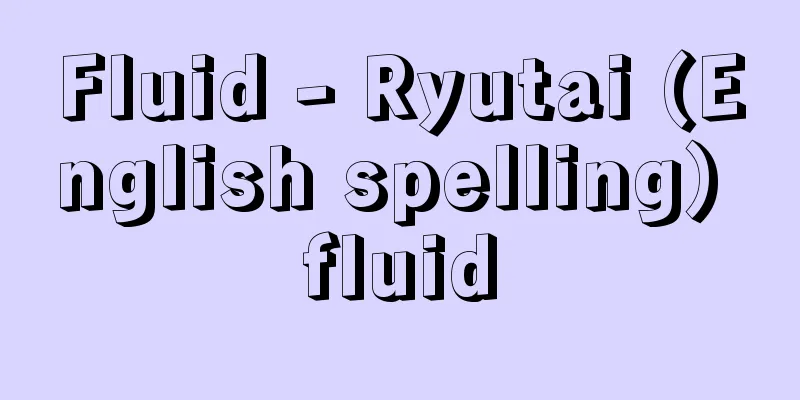Fluid - Ryutai (English spelling) fluid

|
Objects are usually classified into three categories: solids, liquids, and gases. Of these, liquids and gases share the property of being easily deformed, and therefore their way of movement is similar. In other words, their movement is "flowing." Therefore, liquids and gases are collectively called fluids. The study of the movement of fluids is known as fluid mechanics. Real objects are made up of many atoms and molecules, but it is convenient to consider the properties and motion of objects by taking the average of many molecules, without going into such minute structures. When using this method, the object is called a continuous object. When liquids and gases are called fluids, they are considered to be continuous objects. When a force is applied to an object, it is in a state of tension. The concept of stress is used to quantitatively express this. In other words, consider an arbitrary plane S that passes through an arbitrary point P inside the object, and the force (per unit area) that the parts of the object on both sides of S exert on each other is called stress. The component of stress perpendicular to the plane is called normal stress, and the component parallel to the plane is called tangential stress. Also, when the parts of the object on both sides of the plane push against each other, the normal stress is called pressure, and when they pull against each other, it is called tension. For the same point P, the stress varies depending on the plane S. The property of a fluid to easily deform can be expressed as "tangential stress is zero at rest, and normal stress is pressure." This is because if tangential stress exists, the fluid will be displaced, and if normal stress is tension, the fluid will tear, so in either case, the fluid cannot be at rest. Furthermore, in a fluid at rest, the magnitude of pressure has a constant value regardless of the plane chosen for the stress. This type of stress is called hydrostatic pressure. In other words, the tension at each point inside a stationary fluid is expressed only by pressure. [Imai Isao] Fluid MotionTangential stress can also exist when a fluid is in motion. For example, if a cylindrical container is filled with water and rotated on a vertical axis, the water, which is initially stationary, gradually begins to move from the part of the container that is in contact with the wall, and eventually rotates together with the container. This shows that a moving fluid can have tangential stress. The property that causes tangential stress in a moving fluid is called the fluid's viscosity. Fluids such as air and water have low viscosity. Therefore, we consider a hypothetical fluid in which no tangential stress appears even when in motion, and this is called a perfect fluid or inviscid fluid. All real fluids are viscous fluids. The density of a liquid hardly changes while it is moving. Therefore, to idealize this, a fluid whose density is always constant is called an "incompressible fluid". In contrast, a fluid whose density can change is called a "compressible fluid". Common sense tells us that gas is a compressible fluid. In general, when a fluid moves, the pressure at each point in the flow changes depending on the speed. However, if the change in speed is small, the change in pressure is small, and therefore the change in density is small even for gas. In that case, gas can be considered as an incompressible fluid. For example, when an airflow with a speed U hits a stationary object, if the speed of the sound wave traveling through that gas is c , then gas can be considered as an incompressible fluid if the Mach number M = U / c is about 0.5 or less. Conversely, liquids may need to be treated as compressible fluids. This is because sound waves are a phenomenon in which changes in density and pressure are transmitted as waves through a medium, and sound waves can also be transmitted through liquids. In addition, asphalt, glaciers, and the earth's crust are also solids in common sense, but they flow and deform over the long term. In other words, they can be discussed as fluids. In other words, concepts such as fluid, perfect fluid, viscous fluid, and non-shrinking fluid were introduced to discuss the mechanical behavior of objects, and do not necessarily correspond to the common sense categories of solid, liquid, and gas. [Imai Isao] [References] | | | | | | | |Source: Shogakukan Encyclopedia Nipponica About Encyclopedia Nipponica Information | Legend |
|
物体は通常、固体、液体、気体の三つに分類される。そのうち液体と気体は容易に変形するという性質を共有するために、その運動の仕方も似通っている。すなわち「流れる」というのがその運動である。それゆえ、液体と気体を一括して流体という。流体の運動を議論するのが流体力学である。 現実の物体は多数の原子・分子から成り立っているが、このような微細な構造に立ち入らないで、多数の分子について平均をとって物体の性質や運動を考えるのが便利である。このような方法を用いるとき、物体を連続物体という。液体と気体を流体という場合、連続物体の立場がとられる。 力を加えられた物体は一種の緊張状態にある。これを数量的に示すために応力stressの概念が使われる。すなわち、物体内部の任意の点Pを通る任意の平面Sを考え、Sの両側の物体部分が互いに及ぼし合う(単位面積当りの)力を応力というのである。面に垂直な応力の成分を法線応力normal stress、面に平行な成分を接線応力tangential stressという。また、面の両側の物体部分が互いに押し合う場合には法線応力は圧力pressure、引っ張り合う場合には張力tensionという。同一の点Pについても、面Sのとり方によって応力はいろいろ変わる。流体が容易に変形するという性質は、「静止状態では接線応力はゼロで、法線応力は圧力である」と表現することができる。なぜなら、もしも接線応力が存在すれば、流体はずり動かされるし、もし法線応力が張力であれば流体は張り裂けるので、いずれにしても流体は静止状態にはありえないからである。さらに、静止状態にある流体では、圧力の大きさが応力を考える面の選び方によらず一定値をもつことになる。このような応力を静水圧という。すなわち、静止流体の内部の各点での緊張状態は圧力のみで表される。 [今井 功] 流体の運動流体が運動する場合には接線応力も存在しうる。たとえば、円筒形の容器に水を入れ、軸を鉛直にして回転させると、最初静止していた水は容器の壁に接する部分からしだいに動き始め、ついには容器と一体となって回転する。これは運動中の流体が接線応力をもちうることを示すものである。このように、運動中の流体に接線応力を生じさせる性質を流体の粘性という。空気や水のような流体では粘性が小さい。そこで、運動中でも接線応力が現れないという仮想的な流体を考え、これを完全流体perfect fluidあるいは非粘性流体という。実在の流体はすべて粘性流体viscous fluidである。 液体の密度は運動中ほとんど変化しない。そこで、これを理想化して、密度がつねに一定であるような流体を「縮まない流体incompressible fluid」という。これに反して、密度が変化しうる流体を「縮む流体compressible fluid」という。常識的には気体は縮む流体である。一般に、流体が運動する場合、流れの中の各点の圧力は速度によって変化する。しかし、速度変化が小さければ圧力変化は小さく、したがって、気体でも密度変化は小さい。その場合、気体を縮まない流体とみなすことができる。たとえば、速度Uの気流が静止物体に当たる場合、その気体中を伝わる音波の速度をcとすると、マッハ数M=U/cが0.5程度以下であれば、気体を縮まない流体とみなすことができる。逆に液体は縮む流体としての取り扱いが必要になることがある。音波は媒質中を密度および圧力の変化が波動として伝わる現象であり、液体中でも音波が伝わりうるからである。なお、アスファルト、氷河、地殻なども常識的には固体であるが、長期的には変形しながら流動する。すなわち、流体として議論することができる。つまり、流体、完全流体、粘性流体、縮まない流体などの概念は、物体の力学的な挙動を議論するために導入されたものであって、固体・液体・気体という常識的な分野とはかならずしも一致しないのである。 [今井 功] [参照項目] | | | | | | | |出典 小学館 日本大百科全書(ニッポニカ)日本大百科全書(ニッポニカ)について 情報 | 凡例 |
>>: Current meter - flow meter
Recommend
Yoshi Natsuhara - Unprecedented
…The river was originally the Dongjiang River, on...
Coast defence - coast defense
Defending the coast against enemy invasion from th...
Special tax measures - sozeitokubetsusochi
Based on policy perspectives such as economic pol...
Haruko Ichijo
...The date of the Nyogo's entry into the Imp...
Hadley, J.
…It was based on the same optical principles as t...
Cobear
Also known as tsurukobea. A perennial vine of the ...
Kerawak
American author. A representative of the Beat gene...
game reserve
…Most of the national parks in Africa are for the...
Child born out of wedlock - child born out of wedlock
A child born out of wedlock is one whose parents ...
Heart
The heart is the organ that drives blood circulat...
Toda [city] - Toda
A city in southeastern Saitama Prefecture. It was ...
Ramón Maria Narváez
Spanish military man and politician. He was promo...
Undersea topography - Kaiteikei
The undulating form of the ocean floor. Generally...
Chloride cell
…Then they produce urine that is hypotonic compar...
Nakayama-shi
A senior retainer of the Mito Domain. According to...









![Honami [town] - Honami](/upload/images/67ccdbc79f852.webp)